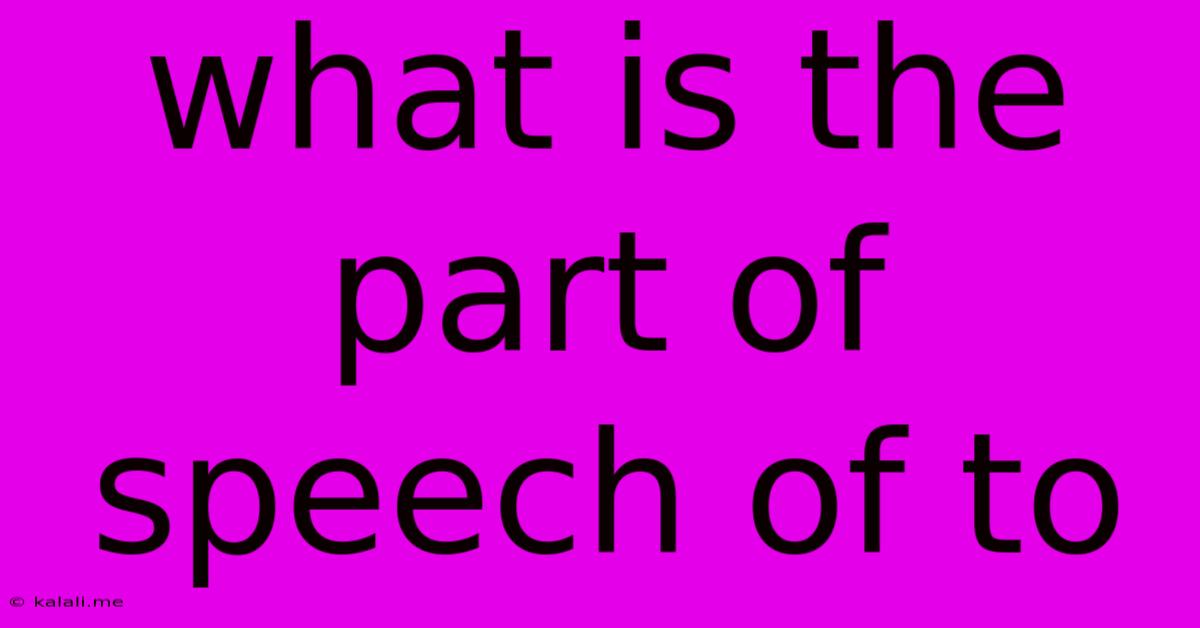What Is The Part Of Speech Of To
Kalali
Jun 05, 2025 · 3 min read

Table of Contents
What Part of Speech is "To"? Unlocking the Mystery of This Versatile Word
The word "to" is a linguistic chameleon, shifting its grammatical role depending on context. It's not simply one part of speech; instead, it flexibly functions as a preposition, an infinitive marker, and even, in rare cases, an adverb. Understanding its multifaceted nature is key to mastering English grammar and improving your writing. This article will delve into each of its functions, providing clear examples and helping you confidently identify "to" in any sentence.
Understanding the Different Roles of "To"
This seemingly simple word holds surprising complexity. Let's break down its key functions:
1. "To" as a Preposition
This is perhaps the most common usage. As a preposition, "to" indicates direction, location, or purpose. It's followed by a noun or pronoun, forming a prepositional phrase that modifies a verb, adjective, or noun.
- Direction: "I'm going to the store." (Indicates destination)
- Location: "The book is to the left of the lamp." (Indicates position)
- Time: "I'll be there to seven o'clock." (Indicates a time limit or until a certain time)
- Purpose: "She dedicated her life to helping others." (Indicates the purpose or goal)
- Relationship: "The key to success is hard work." (Indicates a relationship)
In these examples, "to" introduces a prepositional phrase, indicating relationships between different elements of the sentence. Note the versatility—it can relate to location, time, purpose, and even abstract concepts.
2. "To" as an Infinitive Marker
This is the second primary function of "to". It signals the infinitive form of a verb, creating a verbal phrase that can function as a noun, adjective, or adverb.
- Noun: "To err is human." (The infinitive phrase acts as the subject of the sentence)
- Adjective: "I have a lot of work to do." (Modifies the noun "work")
- Adverb: "He went to sleep." (Modifies the verb "went")
The key here is that "to" doesn't have an independent meaning in these instances; it simply marks the beginning of the infinitive verb phrase.
3. "To" as an Adverb (Rare)
While less common, "to" can occasionally function as an adverb, particularly in idiomatic expressions. This usage often implies extent or degree.
- "The water was heated to a boil." (Indicates the degree of heating)
- "He's grown to love the job." (Indicates the extent of his feelings)
Distinguishing Between the Uses of "To"
Identifying the part of speech of "to" depends heavily on the surrounding words and the sentence structure. Ask yourself:
- Is it followed by a noun or pronoun? If yes, it's likely a preposition.
- Is it followed by a verb in its base form? If yes, it's likely an infinitive marker.
- Does it indicate extent or degree? If yes, and it's part of an idiomatic expression, it could be an adverb.
By considering the context, you can accurately determine the grammatical role of this versatile word. Mastering this distinction will significantly enhance your understanding of English sentence structure and improve the clarity of your writing.
Latest Posts
Latest Posts
-
Python Moving An Object Class In X And Y Direction
Jun 07, 2025
-
2 Lights 2 Switches 1 Power Source Wiring Diagram
Jun 07, 2025
-
How To Clean Ceramic Range Top
Jun 07, 2025
-
Word For Someone Doing Business For
Jun 07, 2025
-
Til There Are No Skill Checks Just Ability Checks
Jun 07, 2025
Related Post
Thank you for visiting our website which covers about What Is The Part Of Speech Of To . We hope the information provided has been useful to you. Feel free to contact us if you have any questions or need further assistance. See you next time and don't miss to bookmark.